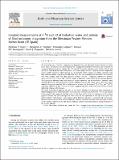Coupled measurements of δ18O and δD of hydration water and salinity of fluid inclusions in gypsum from the Messinian Yesares Member, Sorbas Basin (SE Spain)
Abstract
We studied one cycle (Cycle 6) of gypsum-marl deposition from the Messinian Yesares Member in Sorbas Basin, Spain. The objective was to reconstruct the changing environment of deposition and its relation to astronomically-forced climate change. The δ18O and δD of gypsum hydration water (CaSO4 • 2H2O) and salinity of fluid inclusions were measured in the same samples to test if they record the composition of the mother fluid from which gypsum was precipitated. Water isotopes are highly correlated with fluid inclusion salinity suggesting the hydration water has not exchanged after formation. The relatively low water isotope values and fluid inclusion salinities indicate a significant influence of meteoric water, whereas δ34S, δ18OSO4 and 87Sr/86Sr support a dominant marine origin for the gypsum deposits. The discrepancy between water and elemental isotope signatures can be reconciled if meteoric water dissolved previously deposited marine sulfates supplying calcium and sulfate ions to the basin which maintained gypsum saturation. This recycling process accounts for the marine δ34S, δ18OSO4 and 87Sr/86Sr signatures, whereas the low δ18O and δD values of gypsum hydration water and fluid inclusion salinities reflect the influence of freshwater. The cyclic deposition of gypsum and marl in the Yesares Member has previously been interpreted to reflect changing climate related to Earth's precession cycle. We demonstrate that the δ18O, δD and salinity of the parent brine increased from low values at the base of the cycle to a maximum in the massive gypsum palisade, and decreased again to lower values in the supercones at the top of the cycle. This pattern, together with changes in mineralogy (calcite-dolomite-gypsum), is consistent with a precession-driven change in climate with wettest conditions (summer insolation maxima) associated with the base of the calcium carbonate marls and driest conditions (summer insolation minima) during formation of the gypsum palisade.
Citation
Evans , N P , Turchyn , A V , Gazquez Sanchez , F , Bontognali , T R R , Chapman , H J & Hodell , D A 2015 , ' Coupled measurements of δ 18 O and δD of hydration water and salinity of fluid inclusions in gypsum from the Messinian Yesares Member, Sorbas Basin (SE Spain) ' , Earth and Planetary Science Letters , vol. 430 , pp. 499-510 . https://doi.org/10.1016/j.epsl.2015.07.071
Publication
Earth and Planetary Science Letters
Status
Peer reviewed
ISSN
0012-821XType
Journal article
Description
Financial support was provided by Clare College Geological Research Fund to N.P. Evans. The research leading to these results has received funding from the European Research Council under the European Union's Seventh Framework Programme (FP/2007–2013)/ERC Grant Agreement n. 339694 (Water Isotopes of Hydrated Minerals) to D.A. Hodell.Collections
Items in the St Andrews Research Repository are protected by copyright, with all rights reserved, unless otherwise indicated.

